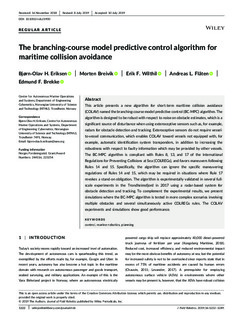| dc.contributor.author | Eriksen, Bjørn-Olav Holtung | |
| dc.contributor.author | Breivik, Morten | |
| dc.contributor.author | Wilthil, Erik Falmår | |
| dc.contributor.author | Flåten, Andreas Lindahl | |
| dc.contributor.author | Brekke, Edmund Førland | |
| dc.date.accessioned | 2019-12-02T09:49:10Z | |
| dc.date.available | 2019-12-02T09:49:10Z | |
| dc.date.created | 2019-10-08T13:18:03Z | |
| dc.date.issued | 2019 | |
| dc.identifier.citation | Journal of Field Robotics. 2019, 36 (7), 1222-1249. | nb_NO |
| dc.identifier.issn | 1556-4959 | |
| dc.identifier.uri | http://hdl.handle.net/11250/2631206 | |
| dc.description.abstract | This article presents a new algorithm for short‐term maritime collision avoidance (COLAV) named the branching‐course model predictive control (BC‐MPC) algorithm. The algorithm is designed to be robust with respect to noise on obstacle estimates, which is a significant source of disturbance when using exteroceptive sensors such as, for example, radars for obstacle detection and tracking. Exteroceptive sensors do not require vessel‐to‐vessel communication, which enables COLAV toward vessels not equipped with, for example, automatic identification system transponders, in addition to increasing the robustness with respect to faulty information which may be provided by other vessels. The BC‐MPC algorithm is compliant with Rules 8, 13, and 17 of the International Regulations for Preventing Collisions at Sea (COLREGs), and favors maneuvers following Rules 14 and 15. Specifically, the algorithm can ignore the specific maneuvering regulations of Rules 14 and 15, which may be required in situations where Rule 17 revokes a stand‐on obligation. The algorithm is experimentally validated in several full‐scale experiments in the Trondheimsfjord in 2017 using a radar‐based system for obstacle detection and tracking. To complement the experimental results, we present simulations where the BC‐MPC algorithm is tested in more complex scenarios involving multiple obstacles and several simultaneously active COLREGs rules. The COLAV experiments and simulations show good performance. | nb_NO |
| dc.language.iso | eng | nb_NO |
| dc.publisher | Wiley | nb_NO |
| dc.rights | Navngivelse 4.0 Internasjonal | * |
| dc.rights.uri | http://creativecommons.org/licenses/by/4.0/deed.no | * |
| dc.title | The branching-course model predictive control algorithm for maritime collision avoidance | nb_NO |
| dc.type | Journal article | nb_NO |
| dc.type | Peer reviewed | nb_NO |
| dc.description.version | publishedVersion | nb_NO |
| dc.source.pagenumber | 1222-1249 | nb_NO |
| dc.source.volume | 36 | nb_NO |
| dc.source.journal | Journal of Field Robotics | nb_NO |
| dc.source.issue | 7 | nb_NO |
| dc.identifier.doi | 10.1002/rob.21900 | |
| dc.identifier.cristin | 1734926 | |
| dc.description.localcode | © 2019 The Authors. Journal of Field Robotics published by Wiley Periodicals, Inc. This is an open access article under the terms of the Creative Commons Attribution License. | nb_NO |
| cristin.unitcode | 194,63,25,0 | |
| cristin.unitname | Institutt for teknisk kybernetikk | |
| cristin.ispublished | true | |
| cristin.fulltext | original | |
| cristin.qualitycode | 1 | |

